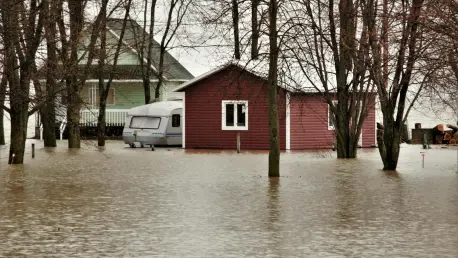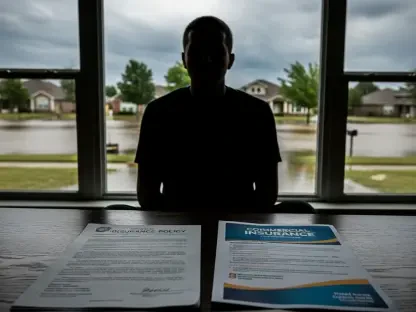As the National Flood Insurance Program (NFIP) faces a critical expiration deadline on September 30, tied to a potential government shutdown, the implications for Florida—a state uniquely vulnerable to flooding—could be devastating. Home to 1.8 million policyholders, the largest share in the nation, Florida relies heavily on this federal initiative to protect residents along its 8,436 miles of coastline and low-lying terrain from the ever-present threat of floods.
Immediate Disruptions from a Program Lapse
The most pressing consequence of an NFIP lapse would be the inability to issue new flood insurance policies after September 30, creating a significant barrier for property transactions across Florida. In many flood-prone areas, coverage is a prerequisite for securing a mortgage, meaning home sales could grind to a halt almost overnight. Additionally, policies expiring during a lapse might lose coverage if premiums are not paid in advance, leaving some homeowners unprotected at a time when hurricanes pose a constant threat. While existing claims would still be processed, the program’s borrowing capacity is capped at $1 billion, a limit that could lead to delays in payouts. During peak storm season, such delays could cripple recovery efforts for families and businesses already grappling with flood damage, amplifying the urgency for a resolution to keep the program operational.
Beyond the transactional gridlock, a lapse would expose a deeper fragility in Florida’s disaster preparedness framework. The timing of this potential disruption, coinciding with heightened hurricane activity, could leave countless residents without the financial safety net needed to rebuild after a storm. Even if claims on current policies are honored, the constrained funding means that payouts might not arrive swiftly enough to meet immediate needs like temporary housing or repairs. This bottleneck could disproportionately affect lower-income households, which often lack the resources to weather extended delays. The ripple effects would extend to local economies, as delayed recoveries slow down community-wide rebuilding efforts. With no new policies available, prospective buyers might also shy away from flood-prone markets, further depressing property values in a state already wrestling with housing challenges.
Florida’s Heightened Exposure to Flood Risks
Florida’s dependence on the NFIP is unparalleled, with nearly 1.8 million policyholders relying on federal support to manage the state’s inherent flood risks. Boasting the longest coastline in the contiguous United States, spanning 8,436 miles, and vast areas of low-lying terrain, the state faces constant threats from storm surges and heavy rainfall. Historical data underscores this vulnerability—over half of all NFIP claims payouts in recent years have gone to Floridians, reflecting the scale of flooding’s impact. A lapse in the program would not only halt new coverage but also jeopardize the financial stability of communities already on edge. Without federal backing, many residents could find themselves unable to afford protection, leaving homes and livelihoods exposed to the next inevitable disaster.
The broader implications for Florida’s housing market are equally alarming if the NFIP falters. Property sales in high-risk zones could stall as buyers struggle to secure mortgages without mandatory flood insurance, a requirement in many areas. This disruption would compound the state’s existing affordability crisis, as homeowners are forced to seek private insurance alternatives that often come with steep premiums. For many, these higher costs could be prohibitive, pushing some to forgo coverage altogether—a risky gamble in a region so prone to flooding. The economic fallout would likely hit hardest in coastal and low-income communities, where resources are already stretched thin. As the state braces for potential storms, the absence of accessible insurance could transform manageable losses into catastrophic setbacks, testing the resilience of entire neighborhoods.
Political Gridlock and Program Uncertainty
The NFIP’s future hangs in a precarious balance, caught in the crosshairs of broader government funding disputes that could trigger a shutdown by September 30. Congressional efforts to extend the program, including proposals for both short-term fixes and longer reauthorization through 2026, are underway but face significant hurdles in the Senate due to partisan disagreements. Complicating matters further is reported tension with the Federal Emergency Management Agency (FEMA), which administers the NFIP, adding a layer of administrative uncertainty. For Florida, where flood insurance is a lifeline, this political stalemate heightens the risk of disruption at a time when stability is desperately needed. The inability to resolve these larger budgetary conflicts could leave millions of policyholders in limbo, with little clarity on when or if relief will come.
Beyond the immediate legislative challenges, the political climate surrounding the NFIP reveals a troubling lack of long-term vision for flood risk management. While temporary extensions have historically prevented permanent lapses, the recurring nature of these expiration threats—over 30 times in recent years—signals a systemic failure to address the program’s sustainability. For Floridians, this uncertainty translates into real-world anxiety, as homeowners and businesses cannot plan effectively without guaranteed access to affordable coverage. The deadlock in Washington also risks eroding public trust in federal disaster support, particularly in a state so reliant on it. As debates drag on, the window to avert a crisis narrows, leaving Florida’s flood-prone regions vulnerable to both natural disasters and policy inaction.
Industry Insights and Economic Fallout
Voices from the insurance and real estate sectors paint a complex picture of the NFIP’s potential lapse, blending concern with cautious optimism about Florida’s ability to weather the storm. Some experts highlight the unprecedented political volatility surrounding this expiration, warning that a lapse could drive homeowners toward private insurance markets where costs are often prohibitively high. Such a shift would exacerbate financial strain for many residents, particularly in a state with already elevated living expenses. Others, however, draw on past patterns of renewal, noting that the program’s critical role in supporting national real estate markets—estimated at 1,300 daily closings—makes a permanent shutdown unlikely. Despite these reassurances, the consensus remains that short-term disruptions could still inflict significant damage, especially in Florida’s flood-heavy regions.
The economic implications of even a temporary lapse are daunting for Florida’s real estate and mortgage industries. A halt in new NFIP policies could freeze property transactions, as lenders typically require flood insurance in high-risk zones before approving loans. This standstill would not only affect individual buyers and sellers but also dampen market confidence, potentially lowering property values in vulnerable areas. Industry stakeholders, including realtors and lenders, emphasize that the fallout would disproportionately burden Florida due to its outsized share of policyholders. While private insurance offers a partial alternative, its higher premiums could price out many families, deepening inequities in access to protection. As the deadline approaches, the tension between immediate economic impacts and the hope for a last-minute resolution underscores the fragility of the state’s flood insurance landscape.
Navigating the Path Forward
Reflecting on the potential lapse of the NFIP, it becomes clear that Florida bears the heaviest burden, with its vast policyholder base and geographic risks magnifying the fallout of any disruption. The immediate threats of halted policies and delayed claims payouts during hurricane season pose real challenges to homeowners and local economies alike. Political gridlock, intertwined with broader funding disputes, only deepens the uncertainty, while industry voices grapple with balancing alarm over rising costs against historical patterns of renewal. In the end, the crisis underscores a critical need for systemic reform to secure the program’s future.
Looking ahead, actionable steps must prioritize stabilizing the NFIP through long-term reauthorization, ensuring that temporary lapses no longer threaten vulnerable states like Florida. Policymakers should explore mechanisms to insulate the program from shutdown risks, while also fostering growth in affordable private insurance options to ease federal dependence. For residents, staying informed about policy expiration deadlines and preparing for potential premium shifts remains essential. Strengthening community-level disaster preparedness can further mitigate impacts, offering a buffer against future uncertainties. Ultimately, a collaborative push for sustainable flood risk management will be vital to safeguard Florida’s future against both natural and legislative storms.









